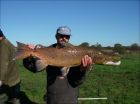(Press-News.org) Synthetic collagen has a wide range of applications in reconstructive and cosmetic surgery and in the food industry. For proper function in animals a certain number of prolines within the protein need to be hydroxylated. BioMed Central's open access journal BMC Biotechnology reports that for the first time the α1 chain of type 1 collagen has been produced in maize with similar levels of proline hydroxylation to human collagen.
Most collagen used is derived from animals but there are risks associated with this collagen containing infectious agents or being rejected by the body. To avoid this problem several laboratory–based systems have been developed using plants to produce collagen. Plant-derived recombinant proteins should have lower contamination and fewer infectious agents, but these systems are unable to make modifications to the protein essential for proper function in human cells.
Working in collaboration with industrial partners researchers added a gene, which codes for the α1 chain of human CI (hCI α1), to maize along with genes which make human prolyl 4-hydroxylase. This second protein was able to hydroxylate approximately the same percentage of prolines in the recombinant collagen α1 chain, produced in maize, as seen for human collagen made in human cells.
Dr Kan Wang from Iowa State University said, "Producing human collagen in maize seeds is an inexpensive alternative to using animal-derived collagen. The seeds are easy to grow, process, and store. Our transgenic plant system is also able to produce a protein with human-like modifications making it a better choice for a wide range of applications."
###
Notes to Editors
1. Hydroxylation of recombinant human collagen type I alpha 1 in transgenic maize co-expressed with a recombinant human prolyl 4-hydroxylase
Xing Xu, Qinglei Gan, Richard C Clough, Kamesh M Pappu, John A Howard, Julio A Baez and Kan Wang
BMC Biotechnology (in press)
Please name the journal in any story you write. If you are writing for the web, please link to the article. All articles are available free of charge, according to BioMed Central's open access policy.
2. BMC Biotechnology is an open access journal publishing original peer-reviewed research articles in the manipulation of biological macromolecules or organisms for use in experimental procedures, cellular and tissue engineering or in the pharmaceutical, agricultural biotechnology and allied industries.
3. BioMed Central (http://www.biomedcentral.com/) is an STM (Science, Technology and Medicine) publisher which has pioneered the open access publishing model. All peer-reviewed research articles published by BioMed Central are made immediately and freely accessible online, and are licensed to allow redistribution and reuse. BioMed Central is part of Springer Science+Business Media, a leading global publisher in the STM sector.
Synthetic collagen from maize has human properties
2011-06-24
ELSE PRESS RELEASES FROM THIS DATE:
A thermometer for dinosaurs
2011-06-24
Small heads, large bodies, and a slow metabolism -- these are the characteristics that make us think of dinosaurs as dull, lethargic and cold-blooded giants. However, this image seems to be deceiving. These giant saurians that have been extinct for 65 million years may have been high-performance models of evolution. In cooperation with colleagues from the US, researchers from the University of Bonn have just determined that the body temperature of some large herbivorous dinosaurs was between 36 and 38 degrees Celsius. "Originally, dinosaurs were considered to have been ...
Discovering lost salmon at sea
2011-06-24
Where Atlantic salmon feed in the ocean has been a long-standing mystery, but new research led by the University of Southampton shows that marine location can be recovered from the chemistry of fish scales. Surprisingly, salmon from different British rivers migrate to feed in separate places, and may respond differently to environmental change.
Numbers of Atlantic salmon have declined across their range since the early 1970s, and most researchers believe that conditions experienced at sea are largely to blame. Unfortunately, identifying where salmon go to feed in the ...
Parenting Time Plans in Oregon
2011-06-24
Oregon law requires that a parenting time plan be included in all judgments where minor children are involved.
In Oregon, "parenting time" (called "visitation" in some states) is the scheduled time that each parent has with the children. The parenting time plan is a document that states when the children will be with each parent and how decisions will be made for the parties' children.
The amount of parenting time that each parent has with the children is not necessarily related to whether or not a parent has legal custody in Oregon. In Oregon, ...
Building a better math teacher
2011-06-24
For years, it has been assumed that teachers—specifically math teachers—need to master the content they intend to teach. And the best way to do this is to take courses beyond that content.
Yet in a paper published today in the Education Forum of the journal Science, Dr. Brent Davis of the University of Calgary says research does not support this common belief. There is little evidence that advanced courses in mathematics contribute to more effective teaching.
"You know that feeling, when you try to explain to a child how to add multi-digit numbers, and you realize that ...
Ghrelin likely involved in why we choose 'comfort foods' when stressed
2011-06-24
DALLAS – June 23, 2011 – We are one step closer to deciphering why some stressed people indulge in chocolate, mashed potatoes, ice cream and other high-calorie, high-fat comfort foods.
UT Southwestern Medical Center-led findings, in a mouse study, suggest that ghrelin – the so-called "hunger hormone" – is involved in triggering this reaction to high stress situations.
"This helps explain certain complex eating behaviors and may be one of the mechanisms by which obesity develops in people exposed to psychosocial stress," said Dr. Jeffrey Zigman, assistant professor ...
Ovenbirds eavesdrop on chipmunks to protect nests
2011-06-24
Ground-nesting birds face an uphill struggle to successfully rear their young, many eggs and fledglings falling prey to predators. Now, scientists from the USA have found that some birds eavesdrop on their enemies, using this information to find safer spots to build their nests. The study – one of the first of its kind – is published this week in the British Ecological Society's Journal of Animal Ecology.
Ovenbirds and veeries both build their nests on the ground, running the risk of losing their eggs or chicks to neighbouring chipmunks. Nesting birds use a range of cues ...
Quien es responsable cuando su hijo esta manejando el automovil que usted le presto y se ve involucrado en un accidente de transito en Nueva York?
2011-06-24
Es una historia de la que ningun padre quiere oir hablar, pero que, lamentablemente, todos hemos escuchado alguna vez. Supongamos que "Junior" pide prestado el coche y tiene un accidente. Puede ser que haya chocado simplemente contra un buzon o puede tratarse de algo mas serio. En el caso de accidentes que tengan como resultado lesiones, quien es responsable? "Junior", que solo tiene 16 anos? Sus padres? El propietario registrado del automovil?
Generalmente, de acuerdo con la ley de Vehiculos y Transito de Nueva York, cuando una persona se ve involucrada ...
Who goes there? Novel complex senses viral infection
2011-06-24
Double-stranded (ds) RNA viruses are a diverse group of viruses that include rotaviruses, a common cause of gastroenteritis. The ability of the immune system to detect and destroy viruses is critical for human health and survival. Now, a study published by Cell Press in the June 23rd issue of the journal Immunity identifies a novel sensor that is necessary to activate the immune response to viral infection. The research enhances our understanding of the complex and overlapping mechanisms our immune cells use to thwart infection.
Viruses are infectious agents composed ...
Cautionary tale for people with diabetes: Dog consumed part of a sleeping patient's toe
2011-06-24
Van Nuys, CA – June 23, 2011 – In a case study that illustrates the need for people with diabetes to be cautious of foot injuries and to protect themselves from pets, a woman with numbness in her feet caused by diabetic neuropathy slept through a traumatic episode in which her Jack Russell terrier chewed off part of her slightly infected big toe, according to an article published in this month's issue of the Journal of the American Podiatric Medical Association.
The patient's wound required surgery, and it ultimately led the amputation of her leg, leaving her a double ...
GSA Bulletin highlights: New research posted June 14, 2011
2011-06-24
Boulder, CO, USA - GSA BULLETIN offers pre-issue publication of papers online. Sign up for e-alerts at http://www.gsapubs.org/cgi/alerts or the Bulletin RSS feeds at http://gsabulletin.gsapubs.org/rss/, for first access to new journal content as it is posted.
Research highlights are provided below. Representatives of the media may obtain complimentary copies of GSA BULLETIN articles by contacting Christa Stratton at the address above. Please discuss articles of interest with the authors before publishing stories on their work, and please make reference to GSA BULLETIN ...


